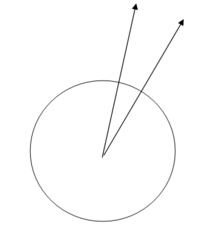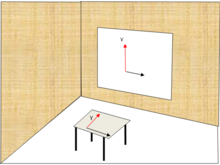Horizontal plane
It has been suggested that portions of this article be split out into another article titled Horizontal and vertical. (Discuss) (March 2013) |

In geometry, physics, astronomy, geography, and related sciences, a plane is said to be horizontal at a given point if it is perpendicular to the gradient of the gravity field at that point— in other words, if apparent gravity makes a plumb bob hang perpendicular to the plane at that point. Alternatively, a spirit level, which exploits the buoyancy of a bubble, can be used to determine if the plane is horizontal.
In radio science, horizontal plane is used to plot an antenna's relative field strength in relation to the ground (which directly affects a station's coverage area) on a polar graph. Normally the maximum of 1.000 or 0 dB is at the top, which is labeled 0o, running clockwise back around to the top at 360°. Other field strengths are expressed as a decimal less than 1.000, a percentage less than 100%, or decibels less than 0 dB. If the graph is of an actual or proposed installation, rotation is applied so that the top is 0o true north. See also the perpendicular vertical plane.
In general, something that is horizontal can be drawn from left to right (or right to left), such as the x-axis in the Cartesian coordinate system.
Discussion
Although the word horizontal is commonly used in daily life and language (see below), it is subject to many misconceptions.
- The concept of horizontality only makes sense in the context of a clearly measurable gravity field, i.e., in the 'neighborhood' of a planet, star, etc. When the gravity field becomes very weak (the masses are too small or too distant from the point of interest), the notion of being horizontal loses its meaning.

- A plane is horizontal only at the chosen point. Horizontal planes at two separate points are not parallel, they intersect.
- In general, a horizontal plane will only be perpendicular to a vertical direction if both are specifically defined with respect to the same point: a direction is only vertical at the point of reference. Thus both horizontality and verticality are strictly speaking local concepts, and it is always necessary to state to which location the direction or the plane refers to. Note that (1) the same restriction applies to the straight lines contained within the plane: they are horizontal only at the point of reference, and (2) those straight lines contained in the plane but not passing by the reference point are not horizontal anywhere.

- In reality, the gravity field of a heterogeneous planet such as Earth is deformed due to the inhomogeneous spatial distribution of materials with different densities. Actual horizontal planes are thus not even parallel even if their reference points are along the same vertical line, since a vertical line is slightly curved.
- At any given location, the total gravitational force is not quite constant over time, because the objects that generate the gravity are moving. For instance, on Earth the horizontal plane at a given point (as determined by a pair of spirit levels) changes with the position of the Moon (air, sea and land tides).
- On a rotating planet such as Earth, the strictly gravitational pull of the planet (and other celestial objects such as the Moon, the Sun, etc.) is different from the apparent net force (e.g., on a free-falling object) that can be measured in the laboratory or in the field. This difference is the centrifugal force associated with the planet's rotation. This is a fictitious force: it only arises when calculations or experiments are conducted in non-inertial frames of reference, such as the surface of the Earth.
Practical use in daily life
The concept of a horizontal plane is thus anything but simple, although, in practice, most of these effects and variations are rather small: they are measurable and can be predicted with great accuracy, but they may not greatly affect our daily life.
This dichotomy between the apparent simplicity of a concept and an actual complexity of defining (and measuring) it in scientific terms arises from the fact that the typical linear scales and dimensions of relevance in daily life are 3 orders of magnitude (or more) smaller than the size of the Earth. Hence, the world appears to be flat locally, and horizontal planes in nearby locations appear to be parallel. Such statements are nevertheless approximations; whether they are acceptable in any particular context or application depends on the applicable requirements, in particular in terms of accuracy.

In graphical contexts, such as drawing and drafting and Co-ordinate geometry on rectangular paper, it is very common to associate one of the dimensions of the paper with a horizontal, even though the entire sheet of paper is standing on a flat horizontal (or slanted) table. In this case, the horizontal direction is typically from the left side of the paper to the right side. This is purely conventional (although it is somehow 'natural' when drawing a natural scene as it is seen in reality), and may lead to misunderstandings or misconceptions, especially in an educational context.
